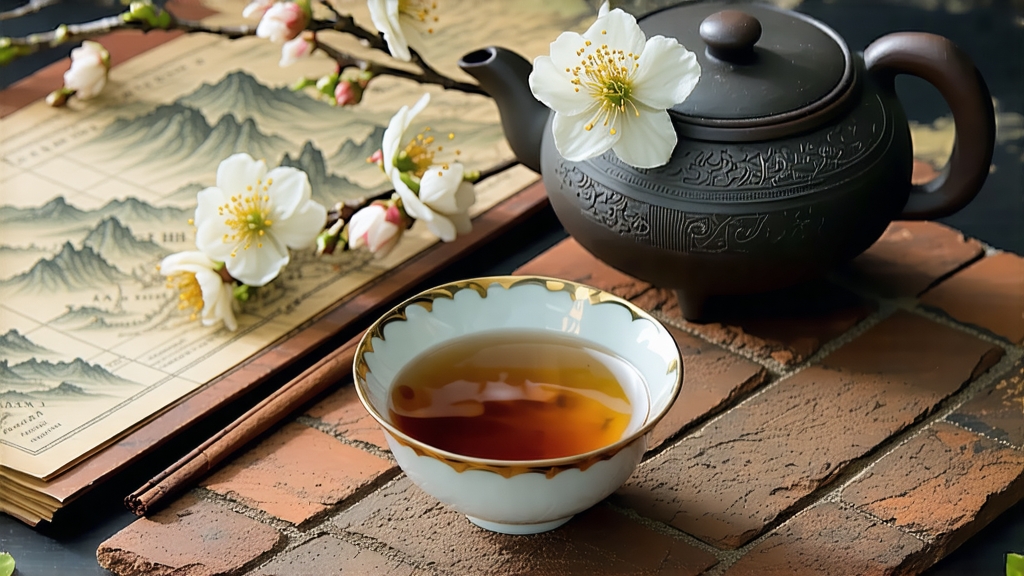
Few beverages carry the quiet gravitas of Fu brick tea (Fú zhuān chá). To the uninitiated it looks like a dusty grey-brown building block, wrapped in rough straw paper and stamped with cryptic Chinese characters. Yet when the brick is cracked open, a constellation of tiny golden grains—scientifically Eurotium cristatum, affectionately called “golden flowers” (jīn huā)—sparkles against the dark leaf. That microscopic embroidery is the signature of one of China’s most storied teas, a sub-species of dark tea (hei cha) that once greased the wheels of frontier trade, healed caravans on the Tibetan Plateau, and still improves in flavor for decades if treated with reverence.
-
Historical footprints along the Hexi Corridor
Fu brick tea was born of geopolitics and hunger. In the 1360s the Ming court, anxious to prevent nomadic armies from trading horses for silver, decreed that only tea could be bartered for steeds. Caravans leaving Xi’an followed the Hexi Corridor westward, but the green teas they carried spoiled in the cold, thin air. Merchants discovered that compressing coarse summer leaf into bricks and allowing it to ferment during the month-long journey created a stable, lightweight currency that nomads could boil with yak butter and salt. The bricks reached Lhasa, Kashgar, and even the Khanates of Central Asia; archaeologists have unearthed 300-year-old specimens whose golden flowers still germinate under a microscope. During the Second World War the Nationalist government used Fu bricks to pay soldiers stationed in Qinghai, proving that tea could literally double as money. -
Terroir and leaf: why only three rivers will do
Authentic Fu brick tea is still produced in a 30-km belt along the Qiūshuǐ River, a tributary of the Wei that cuts through the counties of Jingyang and Jingyangyi in Shaanxi province. The water is alkaline, rich in calcium and magnesium; when sprinkled onto steamed tea leaves it creates a slightly elevated pH that encourages Eurotium to bloom while discouraging spoilage molds. The leaf itself is no delicate spring plucking: farmers harvest the fourth and fifth mature leaves in late July, when the sclerophyll has thickened and the stems have turned reddish—ideal substrates for microbial fermentation. Because the raw material is so rugged, the finished brick can be hammered, dropped from a yak, or soaked in melted snow without disintegrating. -
Crafting the brick: a dance of steam, pressure and spores
The process begins with pan-firing (shā qīng) at 280 °C for three minutes—long enough to denature enzymes but not to drive off all moisture. Next the leaves are rolled, screened, and piled into 1.5-ton heaps for primary wet-piling (wò duī) lasting 12 hours. This brief composting phase cultivates a mixed flora of yeasts and bacteria that pre-digest cellulose. The half-fermented leaf is then steamed for 90 seconds, stuffed into cedarwood molds, and compressed under 25 metric tons of pressure. The crucial act follows: workers sprinkle 0.5 % of “flower seed,” a powdered culture of Eurotium harvested from previous bricks, onto the surface before sealing the brick in linen and straw. During the ensuing 28-day “flowering period” the bricks are stacked like cordwood in an underground cave whose temperature is held at 28 °C and relative humidity at 75 %. Golden flowers propagate inward, forming amber veins that eventually constitute 1–2 % of the brick’s dry weight. Finally the bricks are dried for three days over gentle pine embers, acquiring a faint resinous note that complements the deep fungal aroma. -
The alchemy of aging
Unlike puer, Fu brick tea does not require raw (shēng) and ripe (shóu) distinctions; every brick is already “ripe” when it leaves the factory. Yet it continues to evolve. In the first five years the dominant flavor is wet earth and camphor, underpinned by a lingering sweetness reminiscent of dried longan. From five to fifteen years the golden flowers slowly oxidize, releasing β-ionone and damascenone that perfume the liquor with hints of apricot and dark chocolate. After twenty years the brick begins to “sweat”: volatile terpenes migrate toward the surface, forming a fro